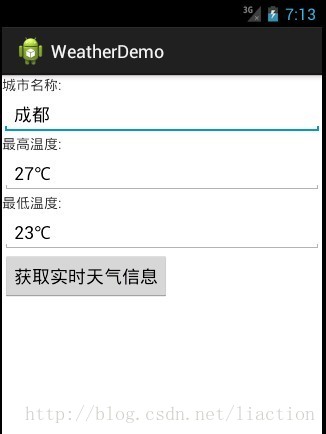天气预报信息获取是利用json获取的,网上有非常多资源,源码。因为上面涉及到非常多天气信息,包含湿度,出行建议等,以及加入了全部城市代码的资源包。为了练手了解json的原理。我仅获取诚笃城市的最高温,最低温,城市名字。
我的布局是通过一个button获取城市名字,最高温,最低温。main.xnl代码例如以下
android:layout_width="match_parent"
android:layout_height="match_parent"
android:orientation="vertical" >
android:id="@+id/textView1"
android:layout_width="wrap_content"
android:layout_height="wrap_content"
android:text="城市名称:" />
android:id="@+id/tx_cityname"
android:layout_width="match_parent"
android:layout_height="wrap_content"
android:ems="10" >
android:id="@+id/textView2"
android:layout_width="wrap_content"
android:layout_height="wrap_content"
android:text="最高温度:" />
android:id="@+id/tx_height"
android:layout_width="match_parent"
android:layout_height="wrap_content"
android:ems="10" />
android:id="@+id/textView3"
android:layout_width="wrap_content"
android:layout_height="wrap_content"
android:text="最低温度:" />
android:id="@+id/tx_low"
android:layout_width="match_parent"
android:layout_height="wrap_content"
android:ems="10" />
android:id="@+id/button_refresh"
android:layout_width="wrap_content"
android:layout_height="wrap_content"
android:gravity="center"
android:text="获取实时天气信息" >
本project含有2个java文件各自是WheatherLck.java和WheatherInfo.java文件。WheatherLck.java代码例如以下
package com.hiden.weatherdemo;
import java.io.BufferedReader;
import java.io.IOException;
import java.io.InputStreamReader;
import org.apache.http.HttpEntity;
import org.apache.http.HttpResponse;
import org.apache.http.HttpStatus;
import org.apache.http.client.ClientProtocolException;
import org.apache.http.client.HttpClient;
import org.apache.http.client.methods.HttpGet;
import org.apache.http.impl.client.DefaultHttpClient;
import org.apache.http.util.EntityUtils;
import org.json.JSONException;
import org.json.JSONObject;
import android.os.Bundle;
import android.os.Handler;
import android.os.Message;
import android.app.Activity;
import android.content.Intent;
import android.util.Log;
import android.view.KeyEvent;
import android.view.Menu;
import android.view.View;
import android.widget.Button;
import android.widget.EditText;
import android.widget.ImageView;
import android.widget.TextView;
public class WeatherLck extends Activity {
// 创建三个全局的文本框对象
EditText TX_CITYNAME,TX_HEIGHT,TX_LOW;
private String city_str="成都";
Button button_refresh;
@Override
protected void onCreate(Bundle savedInstanceState) {
// TODO Auto-generated method stub
super.onCreate(savedInstanceState);
setContentView(R.layout.main);
// 获取布局中的文本框
TX_CITYNAME=(EditText)this.findViewById(R.id.tx_cityname);
TX_CITYNAME.setText(city_str);
TX_HEIGHT=(EditText)this.findViewById(R.id.tx_height);
TX_LOW=(EditText)this.findViewById(R.id.tx_low);
button_refresh=(Button)findViewById(R.id.button_refresh);
button_refresh.setOnClickListener(new View.OnClickListener() {
@Override
public void onClick(View v) {
// TODO Auto-generated method stub
if(v==button_refresh){
refresh(city_str);
}
}
});
/**************************************************************************************
* 获取http://m.weather.com.cn/data/101091106.html上面的数据
* 当中101091106为城市代码,上面我已经把城市代码做了改动,去除了空行,格式为UTF-8
* 每次仅仅是执行一次线程,然后增加主线程回收
* @param city_str
* @throws JSONException
* @throws Exception
* @throws ClientProtocolException
*/
private Thread thread;
private Handler handler = new Handler(){
@Override
public void handleMessage(Message msg){
switch(msg.what){
case 1:
JSONObject weather = (JSONObject) msg.obj;
refreshUI(weather);
try {
thread.join();
} catch (InterruptedException e) {
// TODO Auto-generated catch block
e.printStackTrace();
}
break;
}
}
};
/************************************************************************
* 在主线程中不能请求网络
* 线程没有while循环仅仅是执行一次,假设有溢出可能不能发送消息
* @param city_str
*/
private void requestWeather(final String city_str){
thread = new Thread(new Runnable(){
@Override
public void run() {
// TODO Auto-generated method stub
String url="http://www.weather.com.cn/data/cityinfo/101270101.html";
HttpClient client = new DefaultHttpClient();
HttpGet httpget = new HttpGet(url);
HttpResponse response;
String sbuf = null;
try {
response = client.execute(httpget);
HttpEntity httpentity = response.getEntity();
if(httpentity != null){
BufferedReader br = new BufferedReader(new InputStreamReader(httpentity.getContent(),"utf-8"));
sbuf = br.readLine();
}
JSONObject object = new JSONObject(sbuf);
JSONObject data = (JSONObject) object.getJSONObject("weatherinfo");
//Log.i(TAG, data.toString());
Message msg = new Message();
msg.what = 1;
msg.obj = data;
handler.sendMessage(msg);
} catch (ClientProtocolException e) {
// TODO Auto-generated catch block
e.printStackTrace();
} catch (IOException e) {
// TODO Auto-generated catch block
e.printStackTrace();
} catch (JSONException e) {
// TODO Auto-generated catch block
e.printStackTrace();
}
}
});
thread.start();
}
protected void refresh(String city_str)
{
requestWeather(city_str);
}
private void refreshUI(JSONObject jsonobject){
JSONObject jsonData = jsonobject;
try
{
TX_CITYNAME.setText(jsonData.getString("city"));
// 取得高温数据
TX_HEIGHT.setText(jsonData.getString("temp1"));
// 取得低温数据
TX_LOW.setText(jsonData.getString("temp2"));
}catch(Exception e){
e.printStackTrace();
}
}
}
WheatherInfo.java代码例如以下:
package com.hiden.weatherdemo.ui;
public class WeatherInfo {
String city = "";
String temp1 = "";
String temp2 = "";// 椋庡悜
public String getCity() {
return city;
}
public void setCity(String city) {
this.city = city;
}
@Override
public String toString() {
return "WeatherInfo [city=" + city + ", temp1=" + temp1
+ ", temp2=" + temp2 + "]";
}
public String getTemp1() {
return temp1;
}
public void setTemp1(String temp) {
this.temp1 = temp;
}
public String getTemp2() {
return temp2;
}
public void setTemp2(String temp) {
this.temp2 = temp;
}
}点击button,获得到成都的最高温度和最低温度,效果图例如以下:

当然,大家能够依据自己的需求做出更具体的效果图,比方加入未来5天的天气,定位,加入关注城市等功能。网上资源比較多,大家能够多练习练习。




















 2460
2460











 被折叠的 条评论
为什么被折叠?
被折叠的 条评论
为什么被折叠?








